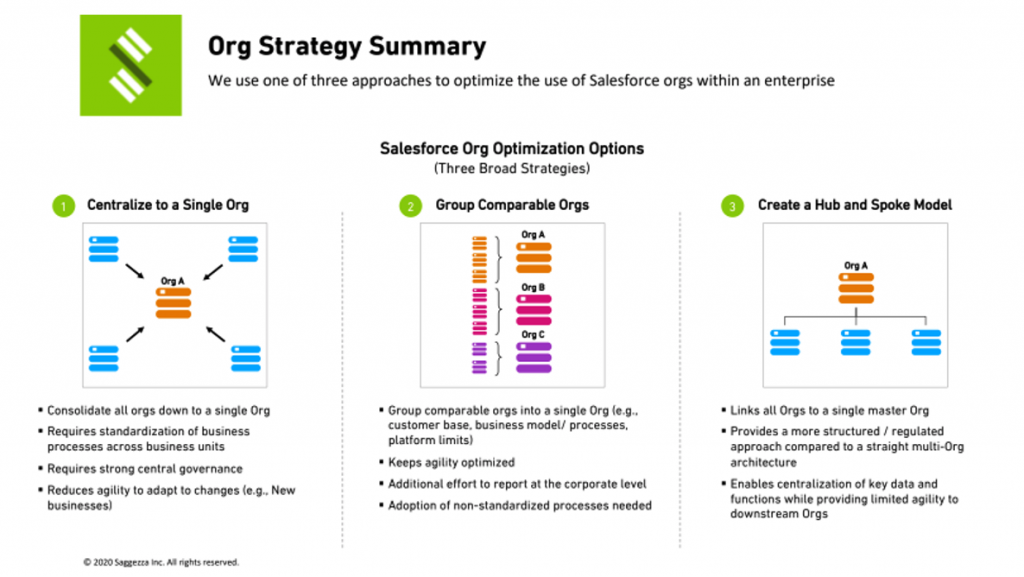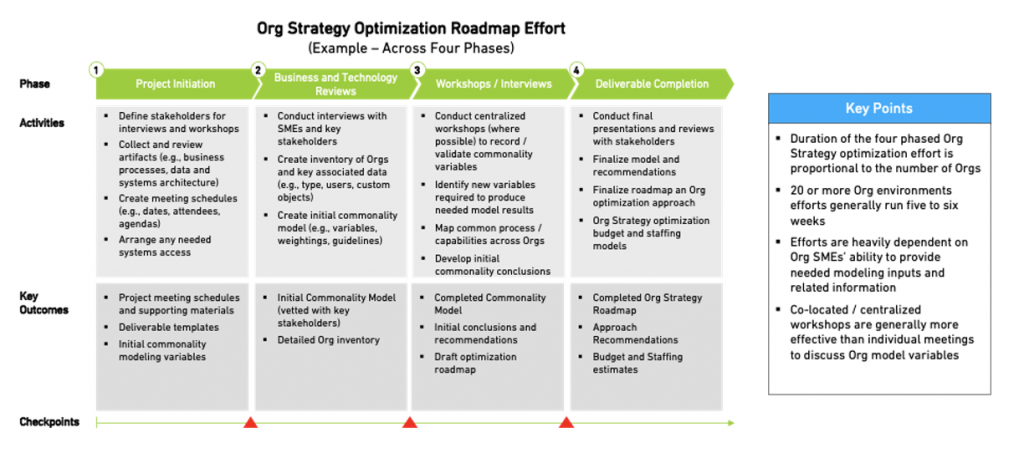
If you’re one of hundreds of thousands of companies that use Salesforce, you know how vital it is to your sales and marketing engine. But the financial advantages of a merger or acquisition can be limited if you don’t find a way to combine existing Salesforce orgs (also referred to as Salesforce instances) while keeping efficiency at the centre.
Here are four steps companies should take to optimise their Salesforce orgs after M&A activity to ensure that their CRM investment continues to pay off.
Step 1: Evaluate key strategic considerations
The first step is to review the strategic business, technical, and organisational considerations that will help you identify the best Salesforce org strategy for your company.
Business considerations include:
- Do the users of the various Salesforce orgs share customers and partners?
- Are there common or distributed business transactions?
- Do the different user groups have similar business operations?
- Who owns the business processes for each team?
- Do the teams share or use interrelated data?
- Are there regulatory barriers to sharing data across business units?
Technical considerations include:
- Do any of your orgs contain a large amount of technical debt or customisations that are causing them to bump up against organisation-wide limits?
- Are reporting needs and security and sharing models similar or different across orgs?
- Are there common workflow rules and data dependencies?
- Do the multiple orgs have or need integrations to the same back office systems?
Organisational considerations include:
- Corporate initiatives
- Change management needs
- IT governance of administration and releases
- IT support for platform and integrations
- Maturity of org(s)
Your company might have other important considerations that aren’t included here, so ensure everything is fully accounted for before moving on to the next step.
Step 2: Identify the best org strategy
After you’ve thoroughly evaluated the considerations above, identify the Salesforce org model that best addresses those considerations. There are three primary models to consider (illustrated in the image below).
Centralise to a single org: In a centralised model, all existing Salesforce orgs are consolidated into a single existing or new Salesforce org. This approach is best for companies who intend to use common processes across various areas of the business, have shared customer bases, and are able to put strong central governance mechanisms in place. It’s generally preferred over the others because:
- Reporting and analysis are streamlined to a central Salesforce org
- Salesforce spend is optimised, or in some cases lowered, by incorporating existing Salesforce licenses into a single org
- It provides for consistent sales and services processes, and access to a common sales pipeline, or case backlog, across the entire enterprise
Group comparable orgs: In a grouped model, multiple Salesforce orgs are merged into fewer orgs that are aligned to common business capabilities.
This model is best for large enterprises with distinct business units that each have different business models and supporting processes. The grouped model makes sense when:
- A company includes multiple business units with drastically different business processes and reporting needs
- The pace of change and disruption is different for each business unit and requires business process changes at a more or less rapid pace than others
- The likelihood of spinning off a division in the future is high
Create a hub and spoke model
This is the least common approach. With the hub and spoke model, all Salesforce orgs are linked and report to a single master org, but the existing orgs maintain their business processes and privacy.
This approach is best for companies that have unique processes that cannot be folded together, or are not able to share data due to privacy laws or outside regulations, but must be able to roll up certain data for reporting purposes.

Step 3: Validate your approach
To ensure your plan is ready for action, meet with key technical and business stakeholders to workshop your new model and ensure it’ll work in practice.
In these workshops, put your assumptions to the test and identify what you’ll need in order to implement the new Salesforce org structure:
- Align on the key considerations across orgs
- Validate existing variables and identify new ones that may not be included in the model, but are needed for decision making
- Validate commonalities and differences
- Discuss licensing concerns and costs
Depending on the business and technical complexities within your company, these workshops could take about two to six weeks to complete.

Step 4: Finalise your roadmap, staffing, and budget
Now it’s time to bring all the pieces together in an org consolidation roadmap.
Your org consolidation roadmap should consider key dependencies, and lay out the timelines for consolidating your Salesforce orgs into your target model. You should get written agreement and understanding from all stakeholders that they are committed to the new structure.
It’s also important to establish a clear governance model: identify which person or organisation maintains control over Salesforce org data and enhancements, and ensure they are staffed appropriately. They will be the go-to for any licensing questions, enhancements, or other concerns when it comes to Salesforce.
Implement the plan
The success of a merger or acquisition heavily depends on making sure Salesforce continues to benefit your company’s bottom line.
After you have buy-in from all stakeholders, it’s time to put your plan into motion. The act of consolidating Salesforce orgs and disparate processes across several lines of business can be painful. That’s why it’s crucial to have a solid communication plan, rollout strategy and data migration plan to achieve the ROI you’re expecting.

Interested in hearing leading global brands discuss subjects like this in person?
Find out more about Digital Marketing World Forum (#DMWF) Europe, London, North America, and Singapore.






